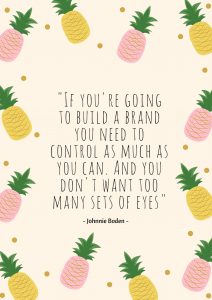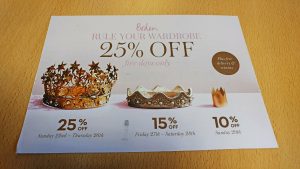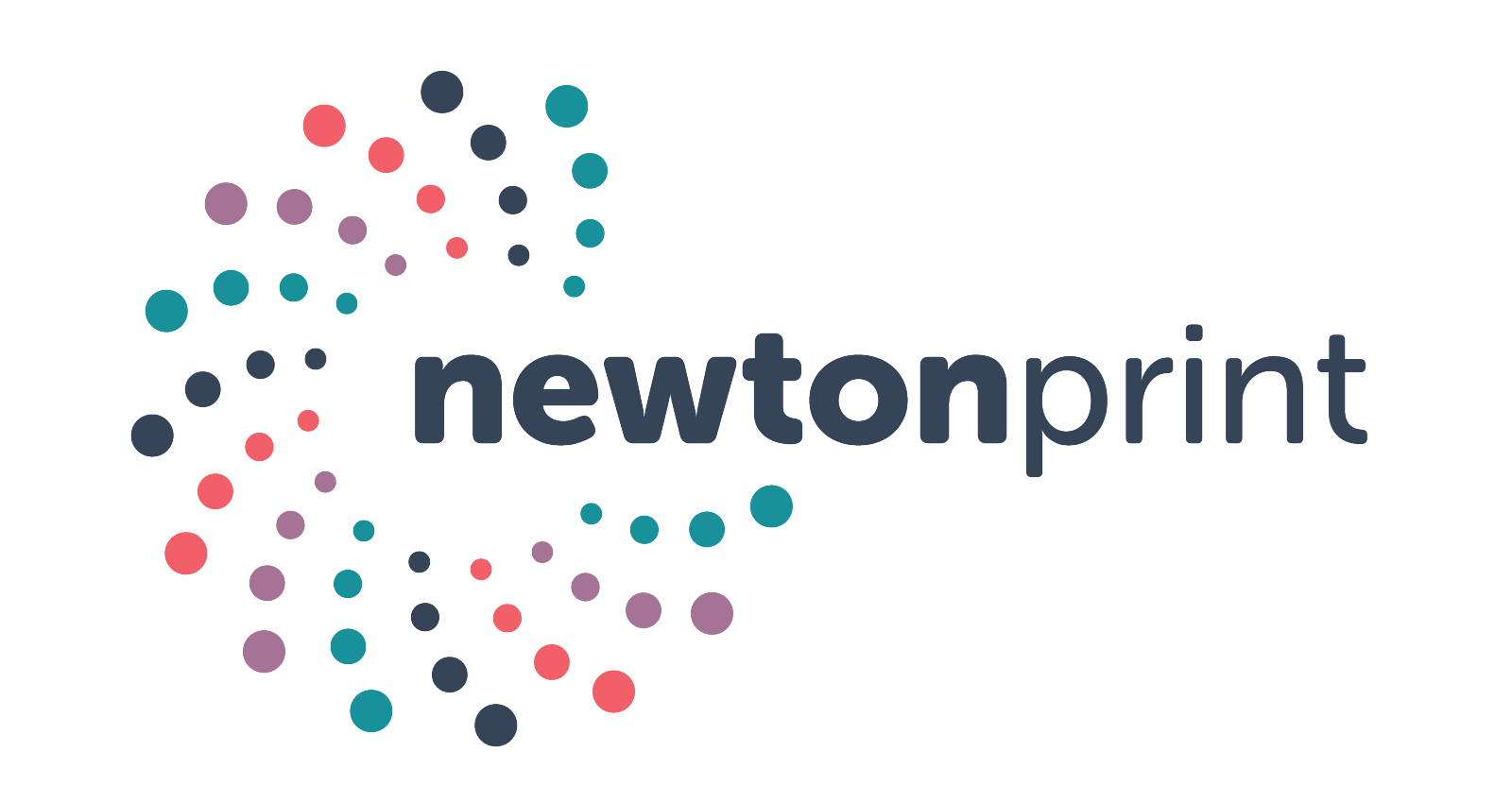Ugly Building, Nice Clothes
That headline is the inscription used on the signage outside Boden’s headquarters; a humble, unassuming industrial building in West London. It’s a bit of a symbol for the entire brand; humble, unassuming yet very friendly and welcoming.
Boden has intrigued me for years: what is it that such a personable, approachable brand has done so well to make it such a success?
I’m sure most reading this will have had some sort of touchpoint with the Boden brand over the years; maybe you’re a customer and see their brilliant Direct Marketing strategies in action for yourself.
This is a brand that was founded by a man with passion and a determined attitude, but also one who has had his fair share of adversity and is ultimately totally approachable. He began in the early 1990’s with a mail-order catalogue and is still going strong now with regular direct mail (both catalogues and promotion postcards).
It’s clearly been a huge success for the company despite the heavily saturated market for clothing brands as well as the struggles that many mid-range brands have experienced in the post-recession years.
So what’s the secret?
PERSONALITY

Johnnie Boden, the company owner, is the very face of his brand. Anyone who has been a recipient of their direct marketing efforts will notice the uniquely light-hearted copy.
There’s no doubt that this suits his target market very well. After all, he’s selling a lifestyle product and needs to appeal to an audience that see lots of ads every day.
The clever bit about it is that his personality has transferred across to the company brand, which permeates the culture, marketing, sales language and everything else. Every piece of marketing message that seeps out of the company oozes Johnnie.
So what he’s managed to do is bring personality to the brand – if you like, he’s created a twin for himself in the form of a clothing company. Likeable, genuine and warm-hearted.
This gives something for customers to engage with. Many of us love a light, refreshing piece of copy to brighten up our day and it is irresistibly attractive when it comes as well-refined as Boden’s.
By doing this, even if Johnnie were to leave the business tomorrow I can guarantee Boden would still thrive and retain its unique character. To customers, it will still feel like they are interacting personally with Johnnie himself. Now that’s how to build a sustainable brand!
FOCUS ON WHAT YOU’VE GOT
 Right from the start, Johnnie was designing the clothes and shooting photography himself. Even now he likes to keep everything in-house (although he has over 1,000 staff to help out).
Right from the start, Johnnie was designing the clothes and shooting photography himself. Even now he likes to keep everything in-house (although he has over 1,000 staff to help out).
That’s a wonderful concept and especially interesting for those of us in marketing. How much do we keep within the team, and how much do we outsource?
Now, I’m a great advocate for the outsider – getting an external view on your brand and strategy from time to time is priceless. We know what it’s like to get so involved in our brands that we can sometimes fail to see the bigger picture, right?
But equally there’s a lot to be said for keeping as much as possible in-house. After all, nobody knows your brand quite as well as those who live and breathe it every day.
It’s true that we often can find out a lot more resource than we ever thought possible if we look inside our own teams and even wider within the organisation. Sales, customer service and marketing teams should be working as one anyway, but how about other staff within the business? You might find out that John down in the warehouse is a wizard with words and could write some cracking copy for your next campaign!
It’s interesting that he highlights the need for control too. Keeping a grip on your brand is really important to keep things consistent – and that’s clearly much easier to do if you have your team internally (or even an extension of your team with a great agency partnership) rather than spread out to lots of different third parties.
UNCOMPLICATED, INNOVATIVE DIRECT MARKETING

Boden’s direct marketing is one of my all-time favourites. They understand that to start a conversation, you often have to go offline with a trusty piece of printed direct mail.
This is something that Boden excels in; from intimately personalised catalogues to fun, easy-to-understand (but ultimately very simple) postcards. All come with a compelling, irresistible Call to Action. But what’s more, the light humour and punchy graphics make people want to read more.
I well remember seeing the Boden catalogues that came through the door with my sister’s name on the front. At the time, that was incredibly innovative. It was also very simple; something that anyone could have done easily enough but they didn’t, so Boden decided to do it.
I saw a postcard of theirs recently; it wasn’t complicated, just a good quality piece of direct mail that was well-designed and well-printed (it wasn’t produced by us, sadly!). The offer was a stepped one – 25% off if you order by X date, 15% if you order by X, 10% if you order by X. That’s a brilliant way to remind people that if they miss the deadline, they can still get a decent offer (just not quite as good as if they act quickly).
That seems to be a theme of Boden’s marketing messages; it makes you feel comfortable but most importantly of all it makes you feel valued. Good quality, well-thought-out direct mail is probably unrivalled in offering that.
Anyone can send out an email or post an ad on social media (I’m not knocking either, by the way!). But if you send your audience an uncomplicated, well-done piece of print they will recognise that you value them as a customer and really do want to engage them.
KNOW YOUR CUSTOMER
Boden have a target audience of customers between 25 to 50. They also have a ‘bulls-eye’ target of a 35-year-old woman who typically has children and is keen to be herself in flattering clothes.
“Sometimes a lot of catwalk trends, for example oversized coats, are hideous. Unless you’re young and skinny it just doesn’t look very nice.”
That’s a perfect example of knowing your customer’s pain points. Because unless you know what they’re fed up with, how can you truly fulfil their needs?
It does take time though – the Boden team have obviously spent a lot of it working out who their target audience is and what sort of needs and wants they have, what really bothers them, their indulgences and secret fancies.
This isn’t being intrusive, it’s the basics of understanding your customer. It’s easy to forget that I’m here in business to serve my customer, not to flog products.
I think it’s also interesting that they have a ‘bulls-eye’ target. It really is so essential to know who your target audience is and focus on just one or two key industries (or groups of people, depending on your business model).
It’s really difficult to be amazing to a hugely diverse target market, but it’s not so hard to offer a remarkable proposition to just 3 or 4 different ones. It gives you much better scope to deeply understand your customer’s needs.
But what really jumps out about Boden’s approach is that, whilst they have a ‘bulls-eye’ specific target, there are also other groups of target customers outside of that. They may not invest as much time or resources in marketing to those other groups but that doesn’t mean they serve them just as superbly.
It’s easy to get a bit bogged down in just how narrowly focussed your targeting should be, but I think Boden’s approach puts it into great perspective. Draw your target audience as a dartboard – with decreasing levels of marketing spend for less critical audiences, but don’t treat them as inferiors if they do come along as customers.
DON’T BE AFRAID TO LOOK OVERSEAS
You know that notorious flat-line bit in the Product LifeCycle where your market is saturated, getting a bit stagnant and could start to nosedive? The bit between Maturity and Decline where you need something to boost revenue or face a bit of a crisis?
Johnnie Boden spotted a very easy way out. Facing a slump in British sales (where design trends change pretty quickly), he decided to focus on international sales. In the US, where he launched in 2002, they are seen as ‘stylish’ which has boosted profits no end.
He’s not abandoned his core British market; far from it. But equally he’s keeping his options open by exploring different markets.
Diversification is a really difficult thing to get right (and make a success of it) but it can come in surprising forms. It might be that your product or service (or some particular feature of it) has huge potential in a foreign market.
Every product needs a bit of a lift from time to time. But to save costs, it might be easier, quicker and more profitable to take your declining product into a new market.
What’s in it for you?
Here’s a bit of a summary:
Bring your brand to life. A bit of a cliché I know, but it says it all. You must give your brand a personality so that people can buy into it, staff and customers alike. It doesn’t need to be tongue-in-cheek like Boden but you have to make sure that your brand has a story and a character of its own;
Look in-house first. If you need to plug a skills gap or need help in a particular area, try looking inside your organisation first. You might be pleasantly surprise by what you find there. There are definitely benefits in outsourcing expertise (especially if you have a small budget) but it should be your aim to bring as much as possible in-house where you have control (and where the best customer knowledge is);
Direct Mail is so powerful. Obviously, there’s a lot to be said for a good piece of print! But honestly, it’s a wonderful conversation starter and will give you the edge over a lot of your competition. Customers love to feel valued and you don’t have to over-complicate things. Just make sure it’s well-designed, contains clear CTAs and is properly printed;
Take the time to deeply understand your audience. If you know exactly who you’re selling to and have detailed knowledge of how they like to buy, what their pain points are and how you can reach through to them, you’re in the strongest position. You can start by talking to your customers. Don’t be afraid to be more focused with your targeting but don’t alienate anyone else who wants to buy even if they don’t fit the Ideal Customer Definition;
Could foreign markets work for you? If you’re struggling to find ways to diversify, try taking your existing products (even if you have to make minor tweaks) to a new international market. You might be pleasantly surprised. There’s loads of help and guidance from the government too.
Do you know of a brand that is successful? How can you learn from what they do well? Maybe you own or manage a brand and want to share your story. Share your insight with us here…
This post is written by our marketing boff Simon Besley and doesn’t necessarily reflect the views of the company; it’s intended to be a helpful review for other marketeers to dissect what I think the brand does well, and how we can all learn from it. If it’s helpful to you, then I’m happy…


